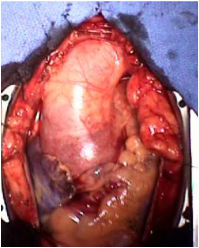Acute Aortic Dissection: General Information

Acute Type A aortic dissection
An acute aortic dissection is when the inner lining of the aorta separates from the middle, muscular layer creating a false channel that allows blood to travel outside the true channel. When the intimal tear occurs, the aorta weakens and expands significantly making the aorta vulnerable to free rupture.
Arteries that originate from the aorta (see anatomy page) may receive blood from either the true, false or both channels. However, the false channel can compromise the flow of blood in the true channel and cause a lack of blood to a particular organ. The false channel can pinch off /compress the true lumen resulting in a lack of blood flow through that branch artery. The false channel can extend throughout the entire length of thoracic and abdominal aorta.
An acute aortic dissection is defined as the presence of a intimal tear and false channel for the first two weeks after the acute event. However, after two weeks it ís classified as a chronic aortic dissection.
Aortic dissections are categorized as either with the Stanford (Type A or B) or Debakey Classifiacation. Most institutions use the Stanford classification because of it's simplicity. A type A aortic dissection is when the intimal tear or false channel involves the ascending aorta (proximal aorta). A type B aortic dissection is defined as the presence of the intimal tear and false channel beyond the subclavian artery
The first line of treatment is medical therapy which involves blood pressure medications which lower your blood pressure and slows down the heart rate which is called: anti-impulse therapy. Patients who suffer a Type A aortic dissection require emergency surgery.
Arteries that originate from the aorta (see anatomy page) may receive blood from either the true, false or both channels. However, the false channel can compromise the flow of blood in the true channel and cause a lack of blood to a particular organ. The false channel can pinch off /compress the true lumen resulting in a lack of blood flow through that branch artery. The false channel can extend throughout the entire length of thoracic and abdominal aorta.
An acute aortic dissection is defined as the presence of a intimal tear and false channel for the first two weeks after the acute event. However, after two weeks it ís classified as a chronic aortic dissection.
Aortic dissections are categorized as either with the Stanford (Type A or B) or Debakey Classifiacation. Most institutions use the Stanford classification because of it's simplicity. A type A aortic dissection is when the intimal tear or false channel involves the ascending aorta (proximal aorta). A type B aortic dissection is defined as the presence of the intimal tear and false channel beyond the subclavian artery
The first line of treatment is medical therapy which involves blood pressure medications which lower your blood pressure and slows down the heart rate which is called: anti-impulse therapy. Patients who suffer a Type A aortic dissection require emergency surgery.
